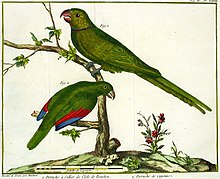Réunion parakeet
It has been suggested that this article be merged with Echo parakeet. (Discuss) Proposed since July 2015. |
| Réunion parakeet | |
|---|---|

| |
| Type illustration by Martinet from 1779 | |
| Scientific classification | |
| Kingdom: | |
| Phylum: | |
| Class: | |
| Order: | |
| Superfamily: | |
| Family: | |
| Subfamily: | |
| Tribe: | |
| Genus: | |
| Species: | P. eques
|
| Binomial name | |
| Psittacula eques (Boddaert, 1783)
| |
| Trinomial name | |
| Psittacula eques eques (Boddaert, 1783)
| |
| Synonyms | |
| |
The Réunion parakeet (Psittacula eques eques) was a little-known parakeet, extinct from about 1770, which formerly inhabited Réunion Island in the western Indian Ocean. It was similar to the echo parakeet of Mauritius. The two may either be distinct subspecies of the same species or the same taxon.
Taxonomy

Its taxonomy is under question, with some considering it a distinct species, while others considering it to be conspecfic with the echo parakeet. Even in that case, ancient DNA analysis of this specimen will give new insight into these questions, because very little data exists on the genetic diversity of the echo parakeet in former times.
In any case, the Réunion and Mauritius birds certainly formed a clade. Until new DNA data is available – and even then only if it would show a significant difference -, it is really a matter of opinion whether one follows a lumper or a splitter approach.
Evolution
Many extant or extinct birds endemic to the Mascarene Islands are derived from South Asian ancestors, including the dodo, and a South Asian provenance has been proposed for the parrots as well. Sea levels were lower during the Pleistocene, so it was possible for species to "island hop" to the isolated islands. Of the about eight endemic Mascarene parrot species, all but one, the echo parakeet, have gone extinct. In spite of many of them being poorly known, fossil remains show that they shared features such as enlarged heads and jaws, reduced pectoral elements, and robust leg elements. Julian Hume has suggested their common origin is within the Psittaculini radiation, based on morphological features and the fact that Psittacula parrots have managed to colonise many isolated islands in the Indian Ocean.[2] This group may have invaded the area several times, as many of the species were so specialised that they may have diverged on hot spot islands before the Mascarenes emerged from the sea.[3] However, a 2012 genetic study showed that the Mascarene parrot was nested among the subspecies of the lesser vasa parrot from Madagascar and nearby islands, and was therefore not related to the Psittacula parrots.[4] This is surprising, due to its anatomical similarities with other Mascarene parrots that are believed to be Psittaculines.[5]
Description

Little evidence even exists of the birds existence. A study skin had been discovered at the Royal Museum of Scotland, explicitly referencing a book description of the Réunion birds. This may be the only material proof of these birds' existence, but its identification has been questioned.[2]
In addition to the study skin, it is known from descriptions, as well as illustrations of which it is unknown whether they were drawn from live or stuffed specimens.[2] It was closely related to the extant but endangered Mauritius parakeet and became extinct in about 1770.[6]
References
- ^ Template:IUCN
- ^ a b c Hume, Julian Pender (2007): Reappraisal of the parrots (Aves: Psittacidae) from the Mascarene Islands, with comments on their ecology, morphology, and affinities. Zootaxa 1513: 1–76 PDF abstract.
- ^ Cheke, A. S.; Hume, J. P. (2008). Lost Land of the Dodo: an Ecological History of Mauritius, Réunion & Rodrigues. T. & A. D. Poyser. ISBN 978-0-7136-6544-4.
- ^ Kundu, S.; Jones, C. G.; Prys-Jones, R. P.; Groombridge, J. J. (2011). "The evolution of the Indian Ocean parrots (Psittaciformes): Extinction, adaptive radiation and eustacy". Molecular Phylogenetics and Evolution. 62 (1): 296–305. doi:10.1016/j.ympev.2011.09.025. PMID 22019932.
- ^ Hume, J. P.; Walters, M. (2012). Extinct Birds. A & C Black. ISBN 140815725X.
- ^ NHM: Reunion Parakeet

